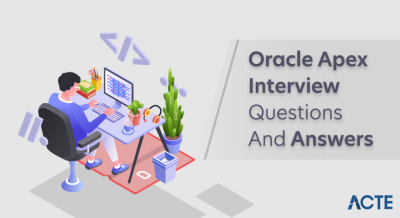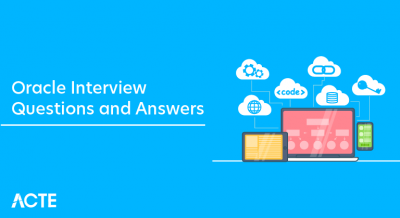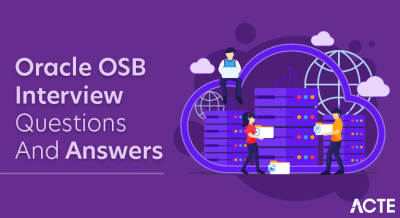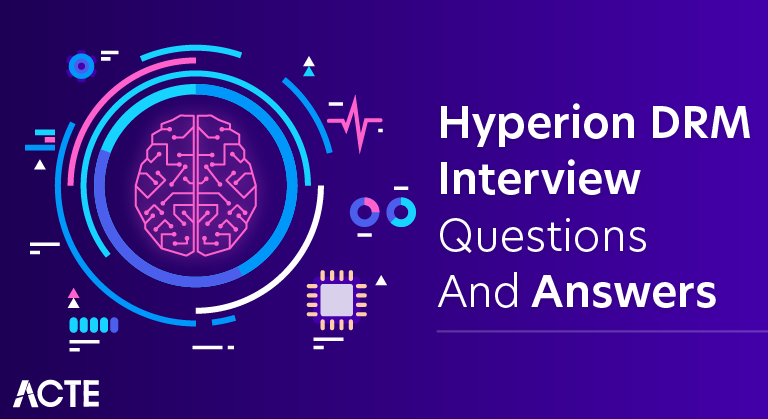
Hyperion DRM is an enterprise change management solution for building and retaining consistency within master data assets despite endless changes necessary to support underlying transaction and analytical systems
1.What is Features of Hyperions?
Ans:
Hyperion as a Name :
Hyperion could be a name used in various contexts, such as a brand, product, project, or even a character in literature or mythology. The features associated with Hyperion would depend on the specific entity or concept it represents.
Hyperion in Technology :Hyperion could be related to technology, such as software or hardware products. For example, Oracle Hyperion is a suite of business performance management (BPM) software. Features in this context would include functionalities related to financial planning, budgeting, forecasting, and consolidation.
2.Describe Hyperion.
Ans:
“Hyperion” can refer to a Titan in Greek mythology associated with the sun, a science fiction novel by Dan Simmons, a suite of business performance management software by Oracle, and a moon of Saturn known for its irregular shape.
3.How does Hyperion Planning work?
Ans:
Oracle Hyperion Planning is a financial planning and budgeting application that streamlines the planning process. Users input financial data, validate and consolidate it, collaborate through workflow features, conduct what-if analyses, and generate reports. The application integrates with other systems, ensures security, maintains audit trails, and is available for both on-premises and cloud deployment.
4.What is Hyperion Finance Management (HFM) in Oracle?
Ans:
Oracle Hyperion Financial Management (HFM) is a financial consolidation and reporting application within the Oracle Hyperion suite. It automates the consolidation process, handles currency translation and intercompany eliminations, and provides tools for creating accurate financial reports. HFM includes features for data validation, workflow, audit trails, and integrates with other systems. It is available for both on-premises and cloud deployment, offering flexibility to organizations in managing their financial processes.
5. What kinds of LOG Files are there?
Ans:
- Essbase.log: General server information and errors.
- Outline.log: Changes to database outlines.
- DataLoadRules.log: Messages for data load rules.
- CalcScript.log: Information on calculation script execution.
- MaxL.log: Details about MaxL script execution.
- essbase.log (Essbase Agent): Essbase Agent activities.
- essbase.sec: Security-related events log.
- essbase.bak: Backup of primary log files.
6.Describe attributes?
Ans:
In Hyperion, attributes are additional details associated with members in dimensions. They provide more information about individual elements, enhancing analysis and decision-making. For example, in a “Products” dimension, attributes could include product category or unit price. Attributes are configurable and contribute to a more comprehensive understanding of business data in Hyperion applications like Essbase or Planning.
7.What effect does attribute dim have on report output?
Ans:
Attribute dimensions in Hyperion Essbase enrich report output by providing additional details about primary dimension members. They enhance analysis, improve formatting, and offer flexibility in reporting. Attribute dimensions can be hierarchically organized, aiding in structured data presentation. However, their use requires a balance to prevent complexity and maintain optimal performance
8.Describe the key elements of Hyperion Planning version 11.1.2.3.?
Ans:
Hyperion Planning version 11.1.2.3, a component of the Oracle Enterprise Performance Management suite, offers a web-based interface for collaborative financial planning and budgeting. It leverages a multidimensional data model, allowing organizations to structure and analyze data across various dimensions like time, geography, and business units. The system supports workflow and approval processes, ensuring a controlled and auditable planning environment. Users interact with the application through customizable data entry forms tailored to organizational requirements. Additionally, Hyperion Planning incorporates a robust calculation engine, enabling the execution of intricate calculations and business rules for detailed financial modeling and analysis.
9.In what way does the Essbase database store data?
Ans:
Essbase stores data in a proprietary multidimensional format using cubes and dimensions. It employs sparse data storage for efficiency, offering Block Storage Option (BSO) for detailed data and Aggregate Storage Option (ASO) for summarized data. Essbase dynamically calculates and aggregates data during queries, ensuring quick retrieval. The system supports data partitioning for scalability and integrates with various enterprise systems for seamless data flow.
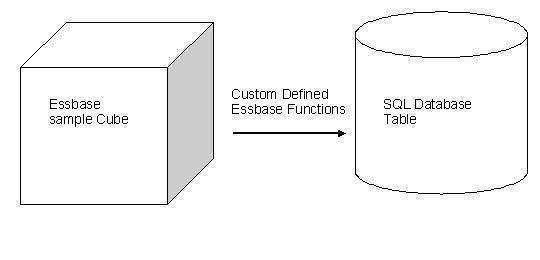
10.How do attribute dimensions and UDAs differ from one another?
Ans:
Attribute dimensions and User-Defined Attributes (UDAs) in Oracle Hyperion Essbase serve distinct roles in enhancing data representation:
Attribute Dimensions :
Purpose : Attribute dimensions add structured details to primary dimension members.
Usage : They provide additional information in a hierarchical format, enriching data context.
Structure : Attribute dimensions are separate hierarchies associated with primary dimensions.
Example: In “Products,” an attribute dimension could include details like color or size.
User-Defined Attributes (UDAs):
Purpose : UDAs are customizable tags for user-assigned classification.
Usage : They offer flexibility for user-defined labeling without a separate hierarchy.
Structure : UDAs are applied directly to members, offering a more ad-hoc classification.
Example: UDAs might label certain products as “High Priority” or “Strategic.”
11.What differentiates Hyperion Essbase ASO and BSO in terms of storage, calculations, dimensionality, and performance?
Ans:
| Feature | ASO (Aggregate Storage Option) | BSO (Block Storage Option) | |
| Storage Mechanism |
Optimized for aggregated and summarized data. |
Designed for storing detailed, granular data. | |
| Calculation Method | Primarily relies on pre-aggregated data. | Supports more complex, on-the-fly calculations | |
| Dimensionality | Recommended for simpler dimensions and hierarchies. | More flexible with complex hierarchies and dimensions. | |
| Performance | Generally faster query performance for read-heavy scenarios. | Flexible but may have trade-offs in query performance, especially with complex calculations or frequent updates. |
12.How does Hyperion Essbase handle data calculations?
Ans:
Hyperion Essbase performs dynamic data calculations using user-defined formulas, business rules, and Calculation Scripts. Its dynamic calculation engine operates on-the-fly during data retrieval, supporting real-time results. Aggregations are conducted based on dimension hierarchies, optimizing the presentation of summarized data. The system offers flexibility through Calculation Scripts and a Rule-Based Calculation Manager for designing and managing complex calculations and business rules. Essbase’s dynamic and adaptable approach facilitates accurate and efficient data analysis.
13.What is the significance of UDAs in Hyperion Essbase?
Ans:
User-Defined Attributes (UDAs) allow users to assign custom tags to dimension members, providing a flexible way to classify and label data.
14.Explain the concept of data partitioning in Hyperion Essbase.
Ans:
Data partitioning in Essbase involves storing data across different files or servers, enhancing scalability and performance in large-scale deployments.
15.What is the role of the Calculation Manager in Hyperion Planning?
Ans:
The Calculation Manager in Hyperion Planning centralizes the design and management of complex calculations and business rules. It facilitates the creation and organization of rules, allowing users to define the execution order and handle multidimensional calculations. Integrated with planning workflows, it ensures seamless execution of calculations within controlled planning processes. Calculation Manager supports data validation, scenario management, and provides enhanced traceability for troubleshooting. Additionally, it incorporates security features to control access to critical business rules, maintaining data integrity.
16.Explain the term “Essbase Aggregate Storage?
Ans:
Essbase Aggregate Storage (ASO) is a storage option in Hyperion Essbase designed for efficient storage and retrieval of aggregated or summarized data. It optimizes performance for applications with large datasets, focusing on rapid access to high-level, aggregated information through a compression mechanism and hierarchical storage. ASO differs from the detailed transaction-level focus of the Block Storage Option (BSO).
17.Can you provide an example of a real-world scenario where Hyperion DRM was implemented successfully?
Ans:
A global corporation implemented Hyperion DRM to standardize master data across business units. This centralized solution enabled consistent hierarchy management, version control, and workflow approvals. Hyperion DRM’s validation ensured data quality, while integration with financial systems streamlined reporting. Security features and multi-language support enhanced data confidentiality and accommodated diverse regions. The implementation resulted in improved accuracy, efficiency, and compliance in financial reporting.
18.How does Hyperion DRM integrate with other Hyperion tools or third-party applications?
Ans:
Hyperion DRM integrates with other Hyperion tools and third-party applications through pre-built adapters, web services/APIs, standard data formats, scripting, change tracking, and direct database connectivity. It also supports integration with middleware and ETL tools, enabling seamless data exchange and synchronization between Hyperion DRM and the broader enterprise ecosystem.
19.What is Hyperion DRM, and what is its role in master data management?
Ans:
Hyperion DRM is a master data management tool by Oracle, centralizing and managing crucial business data like hierarchies and relationships. It ensures consistency through centralized hierarchy management, version control, workflow automation, and data quality enforcement. Integration capabilities link it with other Hyperion tools and third-party applications, while security features and multi-language support enhance data governance. The tool scales with organizational needs, offering a comprehensive solution for effective master data management.
20.Explain the concept of versioning in Hyperion DRM and why it’s important ?
Ans:
Versioning in Hyperion DRM allows for tracking changes to master data over time. It is essential for auditing, enabling historical analysis, reverting to previous data states, ensuring governance and compliance, and facilitating error resolution. This feature provides a comprehensive record of data modifications, contributing to data integrity and effective management.
21.How does Hyperion DRM handle hierarchies, and what are the benefits of centralized hierarchy management?
Ans:
Hyperion DRM manages hierarchies centrally, ensuring consistency across the organization, efficient data maintenance, and streamlined workflows. Version control and multi-language support enhance data quality, while cross-system consistency simplifies reporting and analysis. This centralized approach promotes accuracy, integrity, and adherence to predefined business rules.
22.Describe the workflow functionality in Hyperion DRM and its significance in master data governance?
Ans:
Workflow functionality in Hyperion DRM establishes a controlled and documented approval process for changes to master data. This structured workflow reduces the risk of errors, enhances data governance by enforcing standardized processes, and provides auditability and accountability. Integrated with versioning, it ensures a comprehensive view of the evolution of master data changes over time, promoting efficient change management and adherence to business rules.
23.Can you discuss the different node types in Hyperion DRM and their purposes?
Ans:
Entity Nodes : Represent business entities or organizational units.
Hierarchy Nodes : Define the structure of hierarchies.
Property Nodes : Store additional attributes related to entities or hierarchy nodes.
List Nodes : Define predefined lists of values for attributes.
24.What role does validation play in Hyperion DRM, and how does it contribute to data quality?
Ans:
Validation in Hyperion DRM ensures data quality by enforcing standards, preventing inconsistencies, and supporting governance. It facilitates error identification, enhances data integrity, and streamlines data entry processes, meeting compliance requirements. Customizable business logic tailors validation to the organization’s unique needs, contributing to accurate and reliable master data management.
25.How does Hyperion DRM support multi-language data, and why is it important in a global context?
Ans:
Hyperion DRM supports multi-language data through features like alias nodes and multi-language properties, allowing users to represent and manage master data in different languages. In a global context, this is crucial for consistency, accuracy, user adoption, compliance with regulations, and facilitating effective collaboration across diverse linguistic environments.
26.Explain the process of data import/export in Hyperion DRM?
Ans:
Data Export :
- Users define selection criteria.
- Configure export format.
- -Run export job.
- Export file delivered.
- Prepare import file.
- Configure import format.
- Run import job.
- Data transformation and validation.
27.What security features does Hyperion DRM provide for controlling access to master data?
Ans:
Hyperion DRM enforces access control through user authentication, role-based access control, and permission nodes. Data security filters and workflow security enable fine-grained restrictions. SSL encryption ensures secure communication, while audit trails, LDAP/Active Directory integration, and two-factor authentication enhance overall security.
28.Discuss the scalability and flexibility of Hyperion DRM in managing evolving master data needs?
Ans:
Hyperion DRM is scalable, efficiently handling growing master data volumes. Its flexible architecture allows easy adaptation to evolving business structures and data models, ensuring agility in meeting changing master data management needs.
29.What is Hyperion DRM, and how does it fit into the Oracle EPM (Enterprise Performance Management) suite?
Ans:
Hyperion Data Relationship Management (DRM) is a master data management tool within the Oracle Enterprise Performance Management (EPM) suite. It focuses on managing hierarchical master data, providing data governance, and facilitating integration with other EPM tools. DRM ensures consistency of master data across the organization, enhancing efficiency in change management and supporting unified reporting and analysis within the EPM suite.
30.Explain the key features and functionalities of Hyperion DRM?
Ans:
Hyperion DRM offers key functionalities for master data management, including hierarchical data management, robust data governance, change management with versioning, seamless integration, workflow management, security controls, and reporting capabilities. It centralizes and ensures the consistency and integrity of master data across the organization.
31.What is the purpose of master data management, and how does Hyperion DRM support it?
Ans:
Master Data Management (MDM) aims to ensure consistency and accuracy of core organizational data. Hyperion DRM supports MDM by serving as a centralized repository, managing hierarchical structures, enforcing data governance, facilitating controlled changes, integrating with other systems, and providing security controls and reporting capabilities. It helps organizations maintain a unified and accurate view of master data across various applications.
32.Can you describe the key components of the Hyperion DRM architecture?
Ans:
The key components of Hyperion DRM architecture include a web interface for user interaction, an application server for processing, a database for storing data, an integration layer for communication, a workflow engine for managing processes, a security module for access control, a metadata repository for storing structural information, batch processing for automation, and reporting/analysis components for insights. These elements collectively support master data management functions within the system.
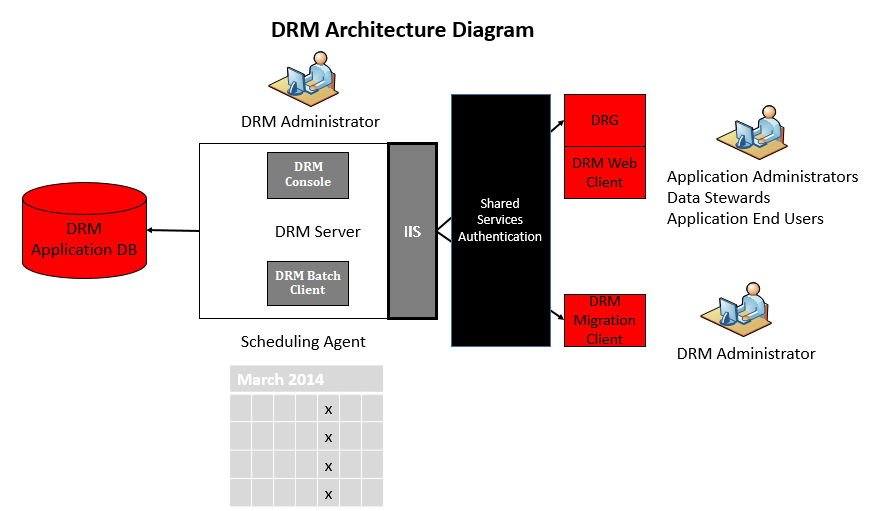
33.How does Hyperion DRM handle versioning and auditing of master data changes?
Ans:
Hyperion DRM manages versioning by capturing snapshot versions of master data at specific times, allowing for incremental updates and historical comparisons. The tool maintains a change history, recording details of modifications, user-specific auditing, metadata changes, and integration with workflows. Comprehensive reporting tools enable users to generate detailed reports on the change history, supporting transparency, accountability, and data governance.
34.Explain the concept of Hierarchies in Hyperion DRM and how they are used?
Ans:
In Hyperion DRM, hierarchies represent structured relationships among data elements in a tree-like format. Nodes are organized into levels, with a root node at the top. Hierarchies are used to organize master data, define data relationships, manage dependencies, enforce data governance, and integrate seamlessly with other EPM processes. They support versioning for tracking changes and maintaining an audit trail, making them essential for maintaining the integrity of master data.
35.How does Hyperion DRM facilitate data governance and ensure data quality?
Ans:
Hyperion DRM facilitates data governance by enabling the definition of business rules, validations, and workflow processes. Security controls and detailed audit trails ensure accountability and transparency. The versioning capability supports auditing and governance by tracking changes over time. To ensure data quality, Hyperion DRM supports validation processes, maintains consistency across EPM applications, enables hierarchical data management, manages metadata, and provides reporting tools for ongoing monitoring and analysis.
36.What are the integration capabilities of Hyperion DRM with other Oracle EPM tools or third-party systems?
Ans:
Hyperion DRM has robust integration capabilities with various Oracle EPM tools, including Planning, Essbase, Financial Management, and Data Integrator. Additionally, it facilitates integration with other systems, including middleware platforms, data warehouses, ERP systems, custom apps, and ETL tools. The tool provides web services and APIs for programmatic access, ensuring seamless data synchronization and automation of processes across the organization.
37.How does Hyperion DRM handle security and access control for users?
Ans:
Hyperion DRM implements security and access control through role-based permissions, defining user roles with specific access levels. Security is applied at the node and property levels, allowing fine-grained control. Security filters restrict user visibility based on criteria, and workflow processes integrate security measures. User authentication is supported, and detailed audit trails track user activities for accountability. Integration with Oracle EPM tools ensures consistency in user access across the suite.
38.Can you explain the difference between Shared Nodes and Local Nodes in Hyperion DRM?
Ans:
In Hyperion DRM, Shared Nodes are nodes shared across multiple versions, ensuring global visibility and consistency. Changes to Shared Nodes are reflected in all versions. Local Nodes, on the other hand, are specific to a version, allowing for version-specific visibility and changes. They are independent of other versions and are used for elements that vary between reporting periods or scenarios. The choice depends on the need for global consistency (Shared Nodes) or version-specific flexibility (Local Nodes).
39.What are the best practices for designing and managing hierarchies in Hyperion DRM?
Ans:
For efficient hierarchy management in Hyperion DRM, start by understanding business needs and carefully planning the structure. Use Shared Nodes for consistency across versions and leverage Local Nodes for version-specific adjustments. Implement thoughtful security measures, establish data governance policies, and regularly review and update hierarchies to ensure accuracy and alignment with changing business requirements. Integration with other EPM tools and effective communication further enhances the effectiveness of master data management.
40.How does Hyperion manage user access and permissions?
Ans:
Oracle Hyperion manages user access and permissions through Shared Services. Administrators use Shared Services to create and organize user accounts, assign users to groups, and define roles with specific permissions. Access Control Lists (ACLs) are then employed to regulate user access to different objects within Hyperion applications, ensuring data security and proper authorization.
41.How does Hyperion DRM support consolidation and harmonization of master data across the enterprise?
Ans:
Hyperion DRM supports enterprise-wide consolidation and harmonization of master data through a centralized repository, hierarchical data management, versioning, auditing, and robust data governance features. Integration with other Oracle EPM tools ensures consistency across applications, while security controls, workflow management, and data integration capabilities contribute to the harmonization of master data. Metadata management, reporting tools, and analysis further enhance the organization’s ability to monitor and maintain data quality consistently.
42.Explain the concept of validations and business rules in Hyperion DRM?
Ans:
In Hyperion DRM, validations are rules applied to master data to ensure quality and adherence to specific criteria, such as format, range, or dependencies. Business rules are logical expressions defining how master data should behave, guiding relationships and enforcing consistency. Both are automated, adaptable, and versioning-compatible; they are essential for preserving data integrity and complying with company policies.
43.What challenges might organizations face when implementing Hyperion DRM, and how can they be addressed?
Ans:
Implementing Hyperion DRM may face challenges such as complex hierarchies, data governance issues, user adoption resistance, integration complexities, workflow challenges, data quality assurance, performance optimization, and change management difficulties. To guarantee a successful implementation and optimize the advantages of master data management, solutions include careful planning, clear communication, user training, strong governance policies, integration testing, performance tuning, and efficient change management techniques.
44.Discuss the role of Hyperion DRM in the context of financial consolidation and reporting ?
Ans:
Hyperion DRM plays a key role in financial consolidation by managing hierarchies, ensuring data consistency, and enforcing governance. Its integration capabilities synchronize master data across financial systems, while workflows streamline data changes. The platform’s versioning, auditing, and security features contribute to reliable and compliant financial reporting, making it essential in optimizing consolidation processes within the Oracle EPM suite.
45.How does Hyperion DRM handle data transformations and mappings between different systems or applications?
Ans:
Hyperion DRM achieves data transformations by integrating with ETL tools, allowing custom scripts, and supporting data mapping. Through web services and APIs, it facilitates programmatic access for transformation needs. The platform’s export/import capabilities and defined transformation rules ensure consistent and accurate master data. With real-time/batch processing and a centralized repository, Hyperion DRM aligns data across systems for accurate reporting and analysis.
46.What role do versions play in Hyperion DRM, and how are they useful in master data management?
Ans:
In Hyperion DRM, versions play a crucial role in master data management by allowing organizations to track changes over time. They provide a historical record, support audit trails, enable scenario analysis, and ensure consistency across environments. Versions are essential for compliance, governance, and facilitating temporal analysis of master data, allowing organizations to make informed decisions and manage data changes in a controlled manner.
47.How does Hyperion DRM handle versioning conflicts, and what resolution options are available?
Ans:
Hyperion DRM handles versioning conflicts by employing a locking mechanism to prevent concurrent modifications. In the event of conflicts, users are notified, and resolution options include merging changes, accepting all, rejecting all, or custom manual resolution. The platform maintains an audit trail for transparency and accountability in conflict resolution, ensuring data integrity and consistency.
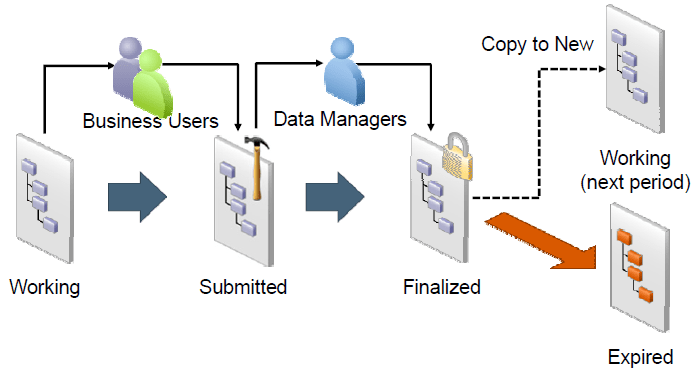
48.Explain the process of creating a new version in Hyperion DRM?
Ans:
To create a new version in Hyperion DRM:
- Navigate to Version Management.
- Select the hierarchy or node.
- Initiate the creation, providing details like name and effective date.
- Optionally set version properties.
- Confirm and finalize the version.
- Assign a status (e.g., “Draft” or “Active”).
- Implement workflow if configured.
- Activate the version after finalization.
- View and compare versions for analysis and auditing.
49.How can you set up security to control user access to specific versions of data in Hyperion DRM?
Ans:
Control user access to specific versions in Hyperion DRM by defining roles, assigning security filters, associating roles with users/groups, configuring version-based permissions, and applying security policies. Regularly review and update settings for ongoing relevance and compliance.
50.Explain the concept of attribute inheritance in Hyperion DRM ?
Ans:
Attribute inheritance in Hyperion DRM allows child nodes in a hierarchy to automatically inherit attribute values from their parent nodes. This promotes efficiency and consistency in master data management by reducing redundancy. Users can customize attribute values at specific nodes while benefiting from default inheritance, ensuring flexibility within the hierarchical structure.
51.Describe the difference between security filters and user/group security assignments in Hyperion DRM?
Ans:
Security Filters :
- Function – Define rules restricting user access to specific nodes, hierarchies, or versions.
- Usage – Enforce data confidentiality by controlling the scope of user visibility and modification capabilities.
- Configuration – Implemented as predefined rules based on node properties or hierarchical relationships.
User/Group Security Assignments :
- Function – Associate users or groups with predefined security roles and permissions.
- Usage – Determine the actions users can perform, such as read, write, or administer, based on their assigned roles.
- Configuration: Involves linking users or groups to specific roles that dictate their access rights in the application.
52.What is the significance of access groups in Hyperion DRM?
Ans:
Access groups in Hyperion DRM streamline security administration by grouping users with similar access needs. They simplify role assignments, facilitate efficient user onboarding, and provide granular access control, enhancing overall manageability and flexibility in the security model.
53.Explain the concept of “Implicit Access” and how it influences user access rights in Hyperion DRM?
Ans:
“Implicit Access” in Hyperion DRM sets the default level of access (read-only or read/write) for users without explicit role assignments. It provides flexibility for quick onboarding, allowing users to interact with the system before specific roles are defined. Role-based access assignments can override implicit access settings, offering fine-tuned control based on user roles and responsibilities.
54.What is the role of workflows in Hyperion DRM, and how do they streamline data change processes?
Ans:
In Hyperion DRM, workflows streamline data change processes by providing a structured framework for reviewing, approving, and managing modifications to master data. They facilitate change control, collaboration among stakeholders, and compliance with data governance policies. Workflows generate a comprehensive audit trail, support scenario analysis, and contribute to versioning mechanisms. The process involves initiation, review and approval stages, notification, conditional routing, and finalization, ensuring a controlled and transparent approach to managing master data changes.
55.Can you discuss techniques for optimizing the performance of Hyperion applications?
Ans:
Cube Design : Design efficient Essbase cubes with consideration for dimension complexity.
Data Loading : Use incremental loading, partition data, and parallelize load processes.
Indexing : Maintain proper indexes on database tables.
Calculation Scripts : Review and optimize calculation scripts, minimizing unnecessary calculations.
Cache Settings : Configure Essbase cache settings based on available memory, adjusting block and page sizes for optimal performance.
56.What is the significance of access groups in Hyperion DRM?
Ans:
Access groups in Hyperion DRM streamline security administration by grouping users with similar access needs. They simplify role assignments, facilitate efficient user onboarding, and provide granular access control, enhancing overall manageability and flexibility in the security model.
57.Explain the concept of “Implicit Access” and how it influences user access rights in Hyperion DRM?
Ans:
“Implicit Access” in Hyperion DRM sets the default level of access (read-only or read/write) for users without explicit role assignments. It provides flexibility for quick onboarding, allowing users to interact with the system before specific roles are defined. Role-based access assignments can override implicit access settings, offering fine-tuned control based on user roles and responsibilities.
58.What is the role of workflows in Hyperion DRM, and how do they streamline data change processes?
Ans:
In Hyperion DRM, workflows streamline data change processes by providing a structured framework for reviewing, approving, and managing modifications to master data. They facilitate change control, collaboration among stakeholders, and compliance with data governance policies. Workflows generate a comprehensive audit trail, support scenario analysis, and contribute to versioning mechanisms. The process involves initiation, review and approval stages, notification, conditional routing, and finalization, ensuring a controlled and transparent approach to managing master data changes.
59.How can you create a new workflow in Hyperion DRM?
Ans:
Create a new workflow in Hyperion DRM by defining steps, assigning participants and roles, configuring conditional routing, setting notifications, creating triggers, and associating it with specific data entities. Test the workflow, deploy it to production, and monitor for adjustments, ensuring a structured process for managing data changes.
60.What is metadata in the context of Hyperion DRM, and why is it important?
Ans:
In Hyperion DRM, metadata refers to additional information and attributes associated with master data, providing context and details. It is crucial for data governance, searchability, reporting, and compliance. Metadata enriches the understanding of master data elements, supporting efficient navigation, analysis, and decision-making within the organization.
61.How does metadata contribute to better understanding and governance of master data in Hyperion DRM?
Ans:
Metadata in Hyperion DRM enhances master data understanding and governance by providing contextual information, supporting data governance practices, improving searchability and navigation, enriching reporting and analysis, documenting data lineage and impact analysis, aiding in audit and compliance efforts, facilitating integration with external systems, and allowing customization for organizational needs. This comprehensive use of metadata ensures transparency, consistency, and informed decision-making in master data management.
62.How does Hyperion DRM support the establishment of data governance policies?
Ans:
Hyperion DRM supports data governance policies through features like metadata management, custom attributes, naming conventions, data quality standards, workflow controls, access controls, security filters, audit trail, versioning, and integration with external systems. These capabilities ensure a structured and controlled approach to master data management, aligning with organizational data governance principles and promoting consistency, accountability, and compliance.
63.Discuss the role of metadata in supporting reporting and analysis activities?
Ans:
In Hyperion DRM, metadata supports reporting and analysis by providing enriched descriptions, serving as additional dimensions for analysis, enabling contextual filtering, facilitating segmentation and grouping, allowing customized report views, improving decision-making through comprehensive information, supporting scenario analysis, ensuring adherence to data governance policies, and capturing historical context. This enhances the depth and context of master data analysis, contributing to more informed decision-making and aligning with data governance principles.
64.How is fragmentation quantified?
Ans:
Fragmentation can be quantified using metrics like the fragmentation index or percentage for file systems and disks. In databases, table and index fragmentation can be measured by assessing the physical arrangement of data. In memory management, a fragmentation index may gauge the efficiency of memory allocation. Tools like defragmentation utilities or database management systems often provide these metrics for analysis.
65.Explain more about BSO and its applications?
Ans:
Binary Space Partitioning (BSO) is a technique dividing space into two regions using hyperplanes, forming a binary tree structure. It’s applied in computer graphics for rendering and collision detection, computational geometry for spatial organization, robotics for path planning, and CAD systems for efficient spatial data management. BSO enhances efficiency in various applications requiring optimized spatial relationships.
66.When does fragmentation happen?
Ans:
Fragmentation occurs when files are created, modified, or deleted in file systems, resulting in non-contiguous storage. In disk systems, continuous write and delete operations can lead to scattered data. In databases, fragmentation arises from insert, update, and delete operations. Memory fragmentation happens during the allocation and deallocation of memory when it occurs in small, non-contiguous blocks.
67.What is the purpose of master data management (MDM) in Hyperion DRM?
Ans:
MDM in Hyperion DRM ensures consistency and accuracy in master data, providing a centralized and standardized view of data across an organization.
68.What is the purpose of data validation rules in Hyperion DRM?
Ans:
Data validation rules ensure that master data adheres to predefined business rules, maintaining data quality and integrity.
69.What is the purpose of cross-reference mappings in Hyperion DRM?
Ans:
Cross-reference mappings link related data between different systems, enabling a unified view of master data across the organization.
70.How can you handle exceptions and errors during data imports in Hyperion DRM?
Ans:
Hyperion DRM provides error handling mechanisms and logs to identify and address exceptions during data imports, ensuring data quality.
71.What is the role of the node cache in Hyperion DRM?
Ans:
The node cache improves performance by storing frequently accessed nodes in memory, reducing the need for repeated database queries.
72.How can you ensure data consistency across multiple environments using Hyperion DRM?
Ans:
Hyperion DRM allows for the promotion of master data changes between environments, ensuring consistency in development, testing, and production environments.
73.Explain the concept of hierarchy versions in Hyperion DRM.
Ans:
Hierarchy versions represent different states or structures of a hierarchy at specific points in time, facilitating historical analysis and comparison.
74.How does Hyperion DRM handle multi-language support?
Ans:
Hyperion DRM supports multi-language environments, allowing users to manage master data in different languages and maintain language-specific labels.
75.Explain the concept of hierarchy root nodes in Hyperion DRM?
Ans:
Hierarchy root nodes serve as the starting points for hierarchies and define the top-level elements in a hierarchy structure.
76.What role does the Node Access Control (NAC) feature play in Hyperion DRM?
Ans:
Node Access Control restricts user access to specific nodes in a hierarchy, ensuring data security and compliance with access control policies.
77.How can you monitor and analyze data changes in Hyperion DRM?
Ans:
Hyperion DRM provides reporting and analysis tools, including audit reports and change tracking, to monitor and analyze data modifications.
78.Explain the process of metadata inheritance in Hyperion DRM?
Ans:
Metadata inheritance allows child nodes to inherit metadata properties from their parent nodes, simplifying the management of consistent metadata.
79.What are the key considerations when planning a Hyperion DRM implementation?
Ans:
Considerations include defining business requirements, designing hierarchies, planning workflows, addressing security needs, and ensuring integration with other systems in the EPM suite.
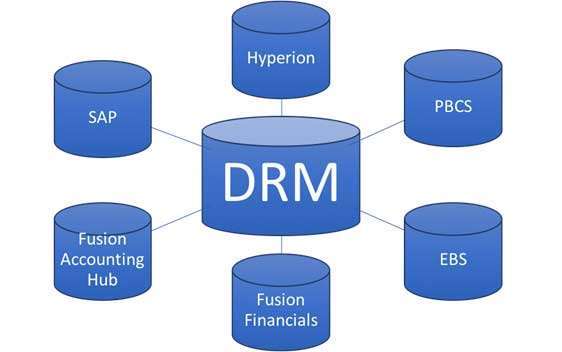
80.How does Hyperion DRM handle multi-language support?
Ans:
Hyperion DRM supports multi-language environments, allowing users to manage master data in different languages and maintain language-specific labels.
81.What role does the Action Script play in Hyperion DRM?
Ans:
Action Scripts automate tasks and processes in Hyperion DRM, enabling users to perform custom actions based on predefined logic.
82.Explain the concept of hierarchy root nodes in Hyperion DRM?
Ans
Hierarchy root nodes serve as the starting points for hierarchies and define the top-level elements in a hierarchy structure.
83.How can you customize the user interface in Hyperion DRM?
Ans:
Hyperion DRM provides customization options for the user interface, allowing organizations to tailor the system to their specific needs and preferences.
84. What is the role of shared properties in Hyperion DRM?
Ans:
Shared properties are properties that can be applied to multiple nodes, providing a consistent set of metadata across related elements.
85.Explain the process of metadata inheritance in Hyperion DRM.
Ans:
Metadata inheritance allows child nodes to inherit metadata properties from their parent nodes, simplifying the management of consistent metadata.
86.How does Hyperion DRM support multi-environment development (Dev, Test, Prod)?
Ans:
Hyperion DRM facilitates multi-environment development through features like versioning and promotion, allowing users to promote master data changes between development, testing, and production environments.
87.Explain the concept of shared nodes in Hyperion DRM?
Ans:
Shared nodes in Hyperion DRM are accessible across multiple hierarchies, providing a centralized representation of data that can be used in different contexts.
88.What is the role of the Action Script in Hyperion DRM, and how is it used?
Ans:
The Action Script in Hyperion DRM automates tasks and processes, allowing users to perform custom actions based on predefined logic. It can be used for automation and customization of various operations.
89.How does Hyperion DRM handle the impact of changes on downstream systems?
Ans:
Hyperion DRM provides features for versioning and impact analysis, allowing users to assess the impact of changes on downstream systems before implementing them.
90.Explain the concept of “version freeze” in Hyperion DRM?
Ans:
Version freeze in Hyperion DRM refers to the ability to lock a particular version of the hierarchy, preventing further changes and ensuring stability for reporting and analysis.
91.What role does hierarchy grouping play in Hyperion DRM?
Ans:
Hierarchy grouping helps organize hierarchies based on common characteristics, making it easier to manage and navigate through related hierarchies.
92.How can you handle changes to metadata properties in Hyperion DRM?
Ans:
Changes to metadata properties in Hyperion DRM can be managed through versioning, allowing users to create and transition between different states of metadata.
93.What are the considerations for designing effective workflows in Hyperion DRM?
Ans:
Designing effective workflows in Hyperion DRM involves considering the approval process, assigning appropriate roles, and ensuring that workflows align with organizational processes.
94.Explain the difference between Hyperion Essbase ASO and BSO.
Ans:
ASO :
- Dense and sparse storage for detailed data.
- Faster for detailed data retrieval.
- Dynamic calculations and support for intricate rules.
- Detailed data scenarios, complex analyses.
- More flexibility in defining complex rules.
BSO :
- Compressed storage for efficient summarization. Data Retrieval Performance:
- Optimized for quick retrieval of summarized data. Calculation and Aggregation:
- Pre-aggregates data, suitable for frequent retrieval of summarized results.
- Large datasets, high-level queries, and efficient summarized data retrieval. Flexibility and Maintenance:
- Simplicity and efficiency for managing aggregated data.


